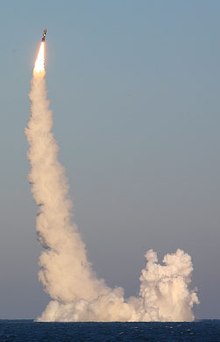A request that this article title be changed is under discussion. Please do not move this article until the discussion is closed. |
| R-30 Bulava[1] | |
|---|---|
 Bulava launched from submarine Yuri Dolgoruky on 28 October 2011 | |
| Type | SLBM |
| Place of origin | Russia |
| Service history | |
| In service | 2018–present[2] |
| Used by | Russian Navy |
| Production history | |
| Designer | Moscow Institute of Thermal Technology |
| Manufacturer | Votkinsk Plant State Production Association |
| Unit cost | $32.2 million (2012)[3] |
| Produced | 2011 |
| Specifications | |
| Mass | 36.8 t (36.2 long tons; 40.6 short tons) |
| Length | 11.5 m (38 ft) (without warhead) 12.1 m (40 ft) (launch container) |
| Diameter | 2 m (6 ft 7 in) (missile) 2.1 m (6 ft 11 in) (launch container) |
| Warhead | 6-10 × 100-150 kt MIRVs[4][5][6] |
| Engine | Three stage solid and liquid head stage |
| Payload capacity | 1150 kg |
| Propellant | Solid propellant and liquid fuel |
Operational range | 8,300 km[7] ≥ 9,300,[8] 15,000km[9][better source needed] |
Guidance system | Inertial guidance, possibly with Astro-inertial guidance and/or GLONASS update |
Launch platform | Borei-class submarines Typhoon-class submarine Dmitri Donskoi (as a testbed)[10] |
The R-30 Bulava (Russian: Булава, lit. "mace", NATO reporting names SS-N-30 / SS-NX-32,[11] GRAU index 3M30, 3K30; bilateral arms control designation RSM-56) is a submarine-launched ballistic missile (SLBM) developed for the Russian Navy and deployed in 2019 on the new Borei class of ballistic missile nuclear submarines. It is intended to serve as a crucial component of Russia's nuclear triad.[12] The weapon takes its name from bulava, a Russian word for mace.[13]
Designed by Moscow Institute of Thermal Technology, development of the missile was launched in the late 1990s as a replacement for the R-39 Rif solid-fuel SLBM.[14] The Project 955/955A Borei-class submarines carry 16 missiles per vessel.
A source in the Russian defense industry told TASS on June 29, 2018, that the D-30 missile system with the R-30 Bulava intercontinental ballistic missile had been accepted for service in the Russian Navy after its successful four-missile salvo launch tests in 2018.[15]
- ^ Cite error: The named reference
tasswas invoked but never defined (see the help page). - ^ ""Mace" is over". www.gazeta.ru. 10 August 2012.
- ^ Ballistic and Cruise Missile Threat (Report). Defense Intelligence Ballistic Missile Analysis Committee. June 2017. p. 33. NASIC-1031-0985-17. Retrieved 16 July 2017.
- ^ Kristensen, Hans M.; Korda, Matt (4 March 2019). "Russian nuclear forces, 2019". Bulletin of the Atomic Scientists. 75 (2): 73–84. Bibcode:2019BuAtS..75b..73K. doi:10.1080/00963402.2019.1580891.
- ^ "Названа дата 14-го запуска "Булавы"" (in Russian). Flot.com. 26 October 2010. Retrieved 1 January 2020.
- ^ "Bulava (SS-NX-30) submarine-based ballistic missile". www.russianspaceweb.com.
- ^ "Russia to Upgrade its Bulava R-30 SLBM Submarine-Launched Ballistic Missile". 27 November 2015.
- ^ Allen, John R.; Hodges, Frederick Ben; Lindley-French, Julian (2021). Future War and the Defence of Europe. Oxford University Press. p. 232. ISBN 978-0-19-885583-5.
- ^ "Here comes Russia's giant Typhoon sub". thebarentsobserver.com. 5 August 2017. Retrieved 17 November 2019.
- ^ "SS-N-30 Bulava – Missile Defense Advocacy Alliance". Retrieved 2024-08-06.
- ^ "Russian military successfully tests new missile". Fox News. 2010-10-07. Retrieved 2012-11-05.
- ^ russianforces.org. Russian Strategic Nuclear Forces http://russianforces.org/blog/2006/04/bulava_has_ten_warheads.shtml.
{{cite web}}: Missing or empty|title=(help)[dead link] - ^ "SS-27 Topol-M / SS-NX-30 Bulava ("Mace")". warfare.ru. 2007. Retrieved 2010-04-07.
- ^ Cite error: The named reference
inservicewas invoked but never defined (see the help page).